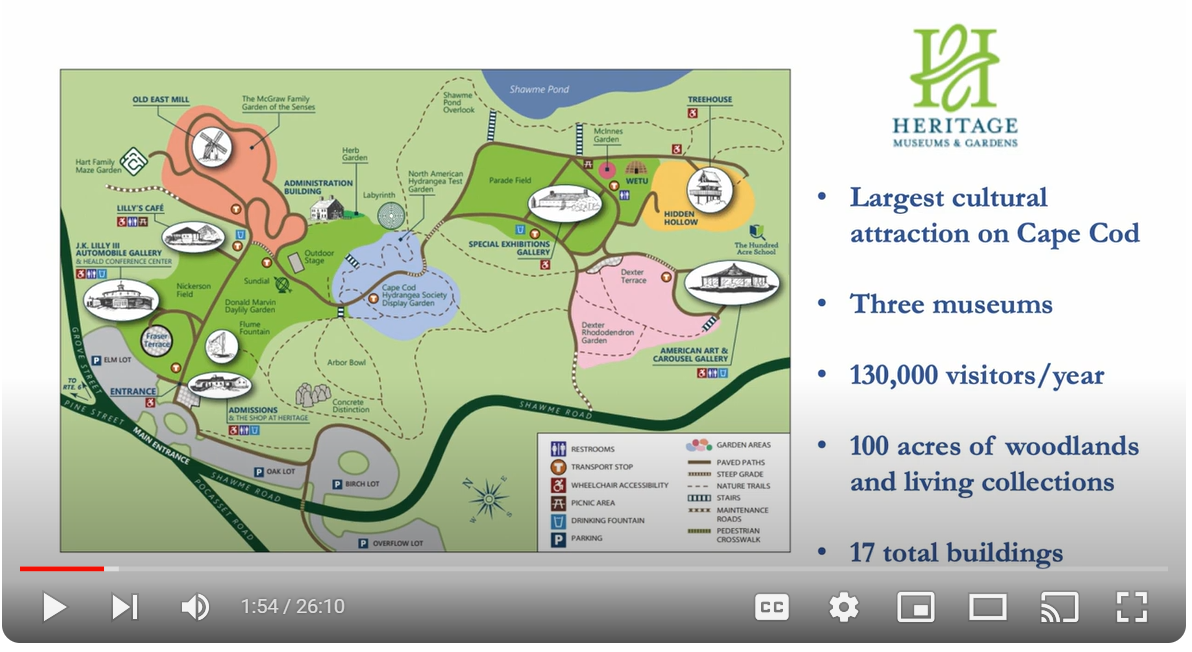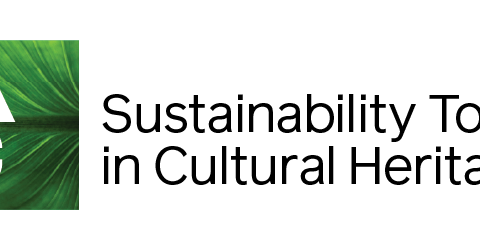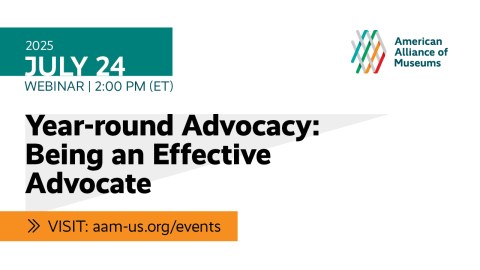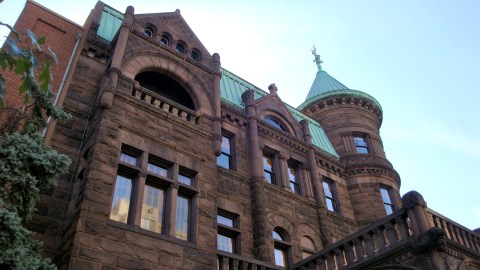
In this recorded session from the 2024 AAM Annual Meeting & MuseumExpo, learn about the Heritage Museums and Gardens’ Strategic Sustainability Plan, which outlines the institution’s strategies and tactics as they aim to become carbon neutral by 2040, along with several related initiatives geared toward enhancing the visitor experience through accessibility improvements and new environmental and sustainable systems.
Additional resources:
Reducing Carbon Emissions in a Complex Environment slides
Transcript
Anne Scott-Putney: This session is a case study at Heritage Museums and Gardens, a 100 -acre site on Cape Cod, where I am the CEO and president, where my two co -presenters are Judith Holtz, on my right, my immediate right. She is one of our trustees, and she is an energy -efficient expert. And to her right is Kate Scurlock, an architect with GWO architects here in Baltimore, who is the architect on our new Welcome Center, which is designed to be net zero.
In this presentation, we will describe our goals for reducing carbon emissions, our sustainability plan for getting us there and the tools that we have put in place to benchmark and also measure our progress. This is a multi-disciplinary approach that we’ve taken to reducing our carbon emissions. This project that we’re gonna be telling you about has actually been replicated at 17 other organizations on Cape Cod and has elements that I would suggest could be replicated in your organizations, and we’re happy to talk to you about that later.
So, let’s get started. I’m really gonna set the scene about our organization and why we consider it to be a complex organization that’s required special care in thinking through how we reduce our carbon emissions.
We are the largest cultural attraction on Cape Cod. We have 130,000 visitors each year, we have 100 acres, 60 of which are woodlands and those are gonna come in handy you’ll learn, and 40 of which are dedicated to living collections and cultivated garden areas. I think what complexifies the situation is that we have 17 total buildings three of which are museum buildings and of the remainder two date from the late 1600s one is a windmill from the 1800s a whole bunch of them were built in the late 60s and 70s when we were founded and one of which houses a carousel and a preschool that actually has grown from being a STEM preschool to a school for children in pre -K through grade two.
So we have a complexity of buildings not only because of their age, but because of their interior spaces, that have meant that they are quite, they take different approaches in thinking about how do we reduce our carbon emissions and our use of fossil fuels.
So about three years ago, I took a graduate museum studies class actually on how to use collections to tell climate stories. And I was really inspired by that class. And I came to understand that not only can we use our collections to tell climate stories, which I’ll tell you about in a minute, but our entire 100 acres can be used as a platform to model and interpret environmental sustainability and how we are working to mitigate the effects of climate change.
When I say model, I just want to make clear that what I mean is to do it, to do it ourselves, to show others how to do it. And by interpret, we all know what that means, which is to help people understand how they can do that back at home or in their organizations. So that was a challenge that I posed to our institution about four years ago.
The result of that was a very chance and wonderful meeting with Judith Holt, who’s now a trustee, who helped us put together our environmental sustainability plan. It’s quite detailed, but in short, this is what we set out to do, to be a model of sustainability for our community, for other Botanic Gardens, and for other organizations and museums, to stop the use of fossil fuels in order to reduce carbon dioxide emissions. And importantly, as a museum, to provide public engagement on these issues through exhibits and education.
Now, Judith is going to get into telling you about all the math and science behind how we set up the benchmarking the analytics and how we measured our progress but I’m going to tell you right now just a little bit about a more qualitative approach to engaging the public on issues of climate change and environmental sustainability and we have done that recently through several different exhibits which I’d like to mention to you.
The first on the upper upper left was an exhibit called creating Cape Cod which was so popular we held it over for a second season we did it last year in the year before and that was an exhibit on how Cape Cod became a tourist attraction and a beloved place for over five million people every year we are located in Massachusetts we have 550 miles of shoreline and for over a hundred years we’ve become a popular tourist destination. We told that story, but we also devoted a third of the exhibit to talking about the impacts of tourism the impact on their water table, the impact on waste, the impact on our non -existent sewer system. We’re all septic. The impact on development, the impact of cars releasing carbon dioxide into the air. And at the same time, how our coastline is being debilitated by the effects of sea level change.
As all good museum exhibits do, when you’re dealing with a difficult topic, we also called out examples of effective approaches to mitigating these effects. But that was all part of our creating Cape Cod exhibit.
The second exhibit, which is really fun. It’s happening right now is below that. That, my friends, is a 1906 Mercury Arc rectifier electric car charger it looks like something out of a steampunk movie but in fact it was one of the very first electric car chargers ever made we have that on display along with the an early car that was used that was charged by a similar charger to that And we also have a second electric, early electric car on display, along with a second charger. We have one of the most beautiful and extraordinary collections of antique cars in our collection.
But not only do we tell those stories, but we’ve used that to tell the story that what is new is actually old and what can we learn from early innovation around electric cars.
Finally, I’ll just point out that we also use other exhibits to convey sustainability messaging. On the upper right is just a slide of our Gardens and Glow, which is our winter light show, but we also message to the public that that is 100 % powered by solar from a local solar farm. In the bottom right, we show one of our outdoor sculpture exhibits. We’ve done those for about five or six years recently and most frequently we work with local artists who use all reclaimed or recycled materials to tell the story about how art can express certain values and in this case related to sustainability.
I’ll turn this other over to Judith now.
Judith Holt: So, we talk a lot about carbon emissions And one way I have figured out to communicate that to people is the fact that a pound of carbon will fill a 23 -inch sphere. And so that’s what this exercise ball is. So, if we filled that sphere with carbon dioxide, that would be one pound of carbon dioxide.
On Cape Cod, the Cape Cod Commission, which is our regulatory commission, has determined that we’re emitting seven billion pounds of carbon dioxide every year. So, imagine from Cape Cod seven billion exercise balls floating up every year. I live in an average size home. My home, I stopped doing this, but my home reduces a ton of carbon dioxide every month. And I live in a very modest home.
So, we try to put our arms around, what does this mean? If it was purple and gooey, we would be all over stopping the emissions of carbon dioxide. So how did we do that at heritage, museums, and gardens? Well, we measured. We measured everything in terms of energy use from the past. We now have 10 years’ worth of data. We measured all the carbon emissions. We converted all that information into carbon emissions. And we’ve also measured carbon sequestration, how much carbon is being drawn back in. We set goals.
And our goals align with the Massachusetts state goals, which are 50 % reduction by the year 2030, which is only six years away, and an 80 % reduction by 2050. Both of these goals are in line with the Paris Climate Agreement as well as the Inflation Reduction Act, goals that were set out on a national level. And then we developed a conservation plan.
We identified all the ways that we could electrify everything that we can and how to deploy solar and renewables. We have a couple ways to do that.
So, we benchmarked. We went to our utility bills. Just pull out your utility bills that’s telling you how much you’re using. And we pulled out 10 years of them. And we put that all into a spreadsheet and then using different formulations, I converted that to BTU so you can compare one fuel type to another fuel type, and then also converted all of that to what kind of carbon is being emitted. And you all have access to this information, I believe.
So here is a summary of the reductions that we’ve had since in the last 10 years up to 2022 the red line on top is the summary line and that so that’s the sum of all the lines below it the yellow line is the electricity line the dark blue line is natural gas and the lighter blue line is propane. We stopped using propane altogether that’s shown at the bottom. When we did that our use of natural gas went up, actually. But, you’ll see that the yellow drops off to zero and the reason for that is that we get to purchase renewable energy off the grid in Massachusetts. So, we started doing that, so that dropped to zero. And it dropped our overall production of carbon dioxide to 50%.
Last year, after we benchmarked all the usage last year that number went up a bit but when Kate describes her project we’re looking forward to that really reducing our carbon emissions dramatically we also conducted a carbon dioxide sequestration project so this is sequestration is the carbon that’s drawn into trees through photosynthesis and that’s a hard word to say and I should not use that word but we had the wonderful help of 25 volunteers for this as well as affiliated organizations that we actually have right on Cape Cod. The Woodwell Institute is one of the global leaders in in particular carbon sequestration And the guy in the upper left -hand corner is Wayne Walker.
He’s the director of that project. He lives in Sandwich, which is where our place is. He said, sure, I’ll come over and help you. So, we set out five plots of land that represent the vegetation on the property. We measured every tree in each of the plots that equaled 316 trees and stems. And we conducted about 5,000 calculations to figure out how much carbon is being pulled into the trees.
You can also figure out how much carbon is being deposited on the earth, we didn’t do that. But that would be an additional number that we could calculate. But we’re very grateful to both Wayne and the Cape Cod Commission. They took our data and they extrapolated it to the full 100 acres. So, they helped us through a GIS system that they have. And they take aerial photographs that are so accurate that you can tell where manholes are.
Just fantastic help. 76% of our property is forest. We also have grasslands, built land, man -made, and bare surfaces. So, we extrapolated our data to all of that.
We take in 8 tons of carbon a year but really it’s 10 tons. And the reason for that is what you see in the image on the right. At heritage there is an overstory of tress, as well as a large understory of rhododendrons. And the rhododendrons are great sequesters of carbon and it was a surprise to me it was one of the things we learned as we did this and they’ve proven this in Pennsylvania they have many studies of this condition and they’re really beautifully scientifically done and it supports the data so we have eight to ten that’s the way we say it um we also looked at all the buildings and determined how to manage them the building in the left side is a barn the round barn that houses our car collection and on the left is a conference center. The conference center emits no carbon dioxide in it’s used because it’s got heat pumps and we’re using solar off the grid. So that’s not emitting any carbon dioxide. The barn on the right on the other hand is still has gas heaters in it they’re condensing heaters they’re very efficient. But, it’s still emitting carbon dioxide so we’re working on, it’s a work in progress. And you can never do it all at once. There are capital expenditures that you can do over time.
In addition to looking at all of the buildings, on the upper side in the photos is the head of horticulture who’s taking the temperature of mulch gathered on site and once it recedes enough sun and gets to a certain temperature it can be moved to a different pile so there’s sequence of piles of mulch so we try to reuse everything we can. We also try to electrify everything we can. On the upper right is our favorite thing that is most photographed on the campus it’s a lawnmower it’s a robot lawnmower and it’s such an intrigue to most people we started only doing that at night because people who are just standing around watching this lawnmower do its thing. It’s very effective though it has a little house that goes back to and recharges itself.
We have also installed EV chargers and we’re electrifying all the transportation on campus. In addition to that, we have water management that includes the use of bioswales wherever we can, so we’re managing water in the direction of water very effectively. And we’re doing subsurface watering at every possible location so that we don’t lose water to the air. And we deploy solar off the grid and we will soon be doing it on site.
And that takes us to Kate.
Kate Scurlock: Thanks Judith so as you just heard from Ann and Judith a major part of Heritage’s project was both setting goals and understanding the existing campus and infrastructure but also looking towards the future and planning for future infrastructure. And the welcome center is one of those future projects and I’m an architect with GWW architects and we’ve had the pleasure of working with Ann and Judith and our team for the last few years to make to turn their new Welcome Center into reality It’s currently under construction, so it’s very exciting. With the groundwork that was laid by Judith and Anne in the plan, as we started talking specifically about the new welcome center, we really were focused on the goals you see on the screen.
One of the major components of that was to model and interpret sustainability and utilizing net zero strategies where we could. Hand in hand with that was providing an improved welcome sequence,
improving accessibility, implementing intuitive wayfinding, and really creating a more gracious welcoming center that expanded the visitor services on campus.
What you see on the screen here is the old welcome center. Ann told me earlier, I can’t call it existing anymore because it is now, it’s now gone. But the building was built for a time when Heritage was seeing about a quarter of the visitors that it’s seeing today.
So on top of it being inefficient from an energy standpoint, it really just wasn’t serving the needs of the campus anymore. Often people walked right past the ticketing windows which were tucked off to the side and straight in to the gardens without paying. So as we were taking all of this information in and working with Ann and her team we really looked at a way to transform that.
So the new welcome center is which is currently under construction will change drastically that visitor arrival experience the buildings are broken down into four pavilions which you see on the screen here surrounding an outdoor courtyard. It provides a chance for visitors to decompress sort of gather themselves before for it and provide the services you need before they embark out into the campus with all the the many wonderful things that heritage has to offer.
You see right here this is the restroom pavilion we have a gift shop and then the visitor services building here so you’ll see and you’ll see it a little bit further and some more graphics but it’s really you know straight right in front of so no one can now miss it and walk past it any longer.
And then the orientation pavilion, which you’ll see again in a few minutes, is situated here. One of the things we were able to take advantage of by nestling this building into the topography is access to a lower level, which provides this new, this is all a new path that I’m tracing here, an accessible loop through the site connecting to an existing portion of the campus. So we’ve been able to transform how the visitors might, we probably don’t even know how much use that we’re going to get out of this path, but it provides the ability to create an accessible loop, which is really great.
So, in addition to designing the building in terms of its function and how to best support the visitor use, a major component of that, of course, was the sustainability goals. So the state of Massachusetts, Judith mentioned, is really at the forefront when it comes to energy codes. They just last year had a new stretch code go into effect, and it’s all towards this goal of reaching net zero emissions in the state by 2050. And the Welcome Center is designed to those standards to really help, as Anne was explaining, be able to model what is local to Cape Cod. So any construction project in the state has to follow these guidelines, and so this is a really great opportunity to model that.
We used a highly insulated building envelope, triple -glazed windows, roof overhangs, a lot of strategies to really help reduce the demands on the heating and cooling loads, which helps bring down the overall energy consumption. And then you see the solar panels illustrated on this rendering, on the roofs, where will we be able to be generating on -site electricity? the buildings are all electric we have no fossil fuels and one of the other components to this to the breaking down of the structures the bill the campus is only open to the public seasonally with some exceptions here and there and so by breaking down those buildings they all have separate systems we’re really a lot we are really providing for the ability that Heritage can close off certain buildings that they don’t need year round again helping to reduce that overall load. Also each building will be fully separately metered so that we can track its performance into the future one other thing i want to point out before i move on is that this courtyard while it looks like it’s a large impervious surface is actually all permeable pavers so any of that surface we’re actually capturing all of that water which is which is really great and it provides an opportunity to use this outdoor space in a number of ways Anne and her team are already planning for how they’re going to have QR codes and interpretive elements within there so that you can really see how what these different things are doing.
So I’m going to click to the next slide and hopefully the video starts for us this is going to be a rendered animation walkthrough And you’ll be able to see, hopefully, what I was just describing as it plays through. This is an existing flume, and you’re seeing the building off in the new building off in the distance. But so as you arrive to the building, the buildings are very low. You’re going to see as this zooms out in a second how from the street, they’re very quiet, not meant to draw attention to themselves, really trying to nestle to the environment. The buildings are clad in all natural materials. We have stone from actually the same quarry that the existing buildings on campus were clad in in a coia wood siding, really trying to reuse existing materials where we can, we’re using old gates, we’re using old wood from the building that we demolished.
You see the plaza, as I mentioned, before you’re getting a glimpse to the gift shop on the right, but really straight ahead of you is that ticketing window so that we’re intuitively bringing people through. It’s very, it would be very hard to miss where you are supposed to get tickets. The restrooms are off to our left. And now we’re entering one of those spaces that was something that was definitely not provided in the existing Welcome Center and it provides a space for interpretation to start to happen for engagement with Heritage’s staff and it gives you a glimpse off into that into the Flume Garden about you know sort of inviting people to go out and to discover that this is a little funny because we’ve hopped down to the lower level but there is an elevator inside but also this exterior stair connecting to that lower level for that loop I was mentioning earlier.
You know, as we were arranging the experience here was we were really focusing on creating these moments where you get a surprise and invite discovery and encourage people to go further, check something else out. So here you see off in the distance is the Flume Plaza, which connects to an existing feature on campus and really creates a larger moment where we invite someone to sit, rest, be surrounded by nature before they continue on with their journey.
I slowed this down a little bit and now it feels slow. Yes, the plantings are actually all going to be done by Anne’s wonderful horticultural staff, and it will incorporate many, many native plants. Again, they also sell those native plants in their store, another way to make that connection for their visitors. And then this is probably soon to be one of the most used spaces on Heritage’s campus, which is a boardroom and also a flexible space for other programming. That, again, features that lovely view out to their garden.
So again, as you can see, from up above the real focus was on how to bring all these things together and create a really perfect marriage of both visitor experience and modeling the sustainability goals of Heritage Museum and Gardens and we’re really excited to see the construction be complete in the summer next year. Or not summer but the spring of next year. And all of the exciting things that will come with that new building.
This recording is generously supported by The Wallace Foundation.








